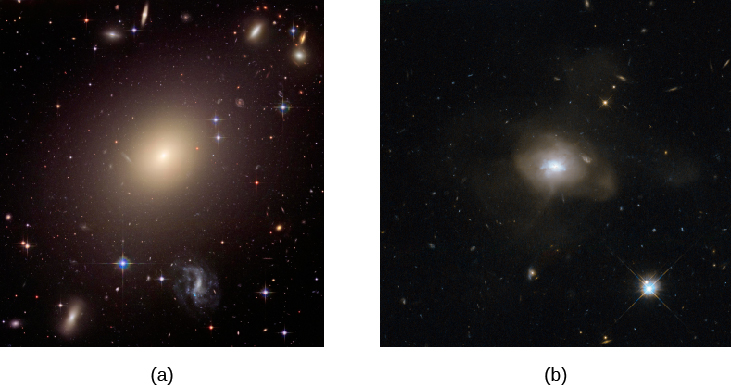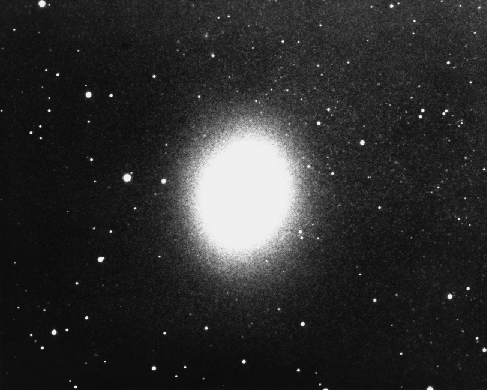| << Chapter < Page | Chapter >> Page > |

Elliptical galaxies show various degrees of flattening, ranging from systems that are approximately spherical to those that approach the flatness of spirals. The rare giant ellipticals (for example, ESO 325-G004 in [link] ) reach luminosities of 10 11 L Sun . The mass in a giant elliptical can be as large as 10 13 M Sun . The diameters of these large galaxies extend over several hundred thousand light-years and are considerably larger than the largest spirals. Although individual stars orbit the center of an elliptical galaxy, the orbits are not all in the same direction, as occurs in spirals. Therefore, ellipticals don’t appear to rotate in a systematic way, making it difficult to estimate how much dark matter they contain.
We find that elliptical galaxies range all the way from the giants, just described, to dwarfs, which may be the most common kind of galaxy. Dwarf ellipticals (sometimes called dwarf spheroidals) escaped our notice for a long time because they are very faint and difficult to see. An example of a dwarf elliptical is the Leo I Dwarf Spheroidal galaxy shown in [link] . The luminosity of this typical dwarf is about equal to that of the brightest globular clusters.
Intermediate between the giant and dwarf elliptical galaxies are systems such as M32 and M110, the two companions of the Andromeda galaxy. While they are often referred to as dwarf ellipticals, these galaxies are significantly larger than galaxies such as Leo I.

Hubble classified galaxies that do not have the regular shapes associated with the categories we just described into the catchall bin of an irregular galaxy , and we continue to use his term. Typically, irregular galaxies have lower masses and luminosities than spiral galaxies. Irregular galaxies often appear disorganized, and many are undergoing relatively intense star formation activity. They contain both young population I stars and old population II stars.
The two best-known irregular galaxies are the Large Magellanic Cloud and Small Magellanic Cloud ( [link] ), which are at a distance of a little more than 160,000 light-years away and are among our nearest extragalactic neighbors. Their names reflect the fact that Ferdinand Magellan and his crew, making their round-the-world journey, were the first European travelers to notice them. Although not visible from the United States and Europe, these two systems are prominent from the Southern Hemisphere, where they look like wispy clouds in the night sky. Since they are only about one-tenth as distant as the Andromeda galaxy, they present an excellent opportunity for astronomers to study nebulae, star clusters, variable stars, and other key objects in the setting of another galaxy. For example, the Large Magellanic Cloud contains the 30 Doradus complex (also known as the Tarantula Nebula), one of the largest and most luminous groups of supergiant stars known in any galaxy.

Notification Switch
Would you like to follow the 'Astronomy' conversation and receive update notifications?